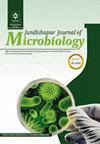肺炎克雷伯菌不同感染者的耐药性、毒力及系统发育分析
IF 0.5
4区 医学
Q4 MICROBIOLOGY
引用次数: 0
摘要
背景:肺炎克雷伯菌是医院感染中的一种重要病原体,可引起泌尿系统和呼吸系统感染、手术部位感染和败血症。近年来,随着临床碳青霉烯类抗生素的广泛使用,耐碳青霉烯的肺炎克雷伯菌呈上升趋势。然而,很少有研究表明肺炎克雷伯菌在不同感染患者中的耐药性、毒力和系统发育之间的关系。目的:研究肺炎克雷伯菌在不同感染患者中的耐药性、毒力和系统发育。方法:选择70例感染者作为研究对象。采用超广谱β-内酰胺酶(ESBLs)彩色筛选平面和血平板培养基进行培养。采用VITEK-2型小型全自动细菌分析仪进行鉴定和耐药性分析。还进行了多基因座序列分型(MLST)和胶囊分型分析。Xpert CarbaR试剂盒检测到碳青霉烯抗性基因。抗生素综合研究数据库(CARD)和毒力因子数据库(VFDB)分别预测了耐药基因和毒力因子基因。构建了系统发育树,并对其相关性进行了分析。结果:共培养出43株肺炎克雷伯菌。我们发现所有肺炎克雷伯菌菌株都表现出不同的多重耐药性。MLST分析表明,ST11是主要的ST(60.61%)。对碳青霉烯类抗生素抗性基因的分析表明,所有分离株都携带blaKPC-2基因和其他一些blaOXA基因。荚膜血基因分型和毒力因子基因预测结果表明,K47、K64和K25是荚膜血的主要类型,毒力基因检测率前三位分别为fimH(97.67%)、mrkD(94.19%)和entB(84.88%),同一ST型或荚膜血型菌株之间的关系更为密切。相关性分析表明,肺炎克雷伯菌感染患者的耐药性与毒力和系统发育呈正相关(r=0.682,P=0.000),可为临床抗菌药物的选择提供参考。本文章由计算机程序翻译,如有差异,请以英文原文为准。
Analysis of Drug Resistance, Virulence, and Phylogeny of Klebsiella pneumoniae in Patients with Different Infections
Background: Klebsiella pneumoniae is an important pathogen among nosocomial infections, which can cause urinary and respiratory system infections, surgical site infections, and sepsis. Recently, carbapenem-resistant K. pneumoniae showed an upward trend with the wide use of clinical carbapenem antibiotics. However, there are few studies on the relationship between drug resistance, virulence, and phylogeny of K. pneumoniae in patients with different infections. Objectives: We investigated the drug resistance, virulence, and phylogeny of K. pneumoniae in patients with different infections. Methods: Seventy infected patients were selected as subjects. The extended-spectrum β-lactamases (ESBLs) color screening plane and blood plate medium were used for culture. Identification and drug resistance analysis was carried out by VITEK-2 compact automatic bacterial analyzer. Multilocus sequence typing (MLST) and capsule genotyping analysis were also performed. The Xpert CarbaR cartridge detected the carbapenem resistance genes. Comprehensive Antibiotic Research Database (CARD) and Virulence Factor Database (VFDB) predicted the drug-resistant genes and virulence factor genes, respectively. The phylogenetic tree was constructed, and the correlation was analyzed. Results: A total of 43 K. pneumoniae strains were cultured. We found that all K. pneumoniae strains exhibited different multiple drug resistance. MLST analysis indicated that ST11 was the main ST (60.61%). Analysis of the carbapenem-resistance genes showed that all isolates harbored the blaKPC-2 gene and some others blaOXA. The prediction result of capsular blood genotyping and virulence factor genes indicated that K47, K64, and K25 were the main types of capsular blood, and the top three detection rates of virulence genes were fimH (97.67%), mrkD (94.19%), and entB (84.88%). All isolates were clustered into one branch based on the virulence factor genes in the phylogenetic tree, and the strains of the same ST type or capsular blood type showed a closer relationship. Correlation analysis manifested that the drug resistance of K. pneumoniae in infected patients was positively correlated with virulence and phylogeny (r = 0.682, P = 0.000). Conclusions: There were complicated differences in the multidrug resistance to K. pneumoniae, resulting in high independent gene-positive rates of strains and a strong correlation with phylogeny, which can provide a reference for the selection of clinical antimicrobial drugs.
求助全文
通过发布文献求助,成功后即可免费获取论文全文。
去求助
来源期刊

Jundishapur Journal of Microbiology
MICROBIOLOGY-
CiteScore
1.30
自引率
0.00%
发文量
56
审稿时长
6-12 weeks
期刊介绍:
Jundishapur Journal of Microbiology, (JJM) is the official scientific Monthly publication of Ahvaz Jundishapur University of Medical Sciences. JJM is dedicated to the publication of manuscripts on topics concerning all aspects of microbiology. The topics include medical, veterinary and environmental microbiology, molecular investigations and infectious diseases. Aspects of immunology and epidemiology of infectious diseases are also considered.
 求助内容:
求助内容: 应助结果提醒方式:
应助结果提醒方式:


